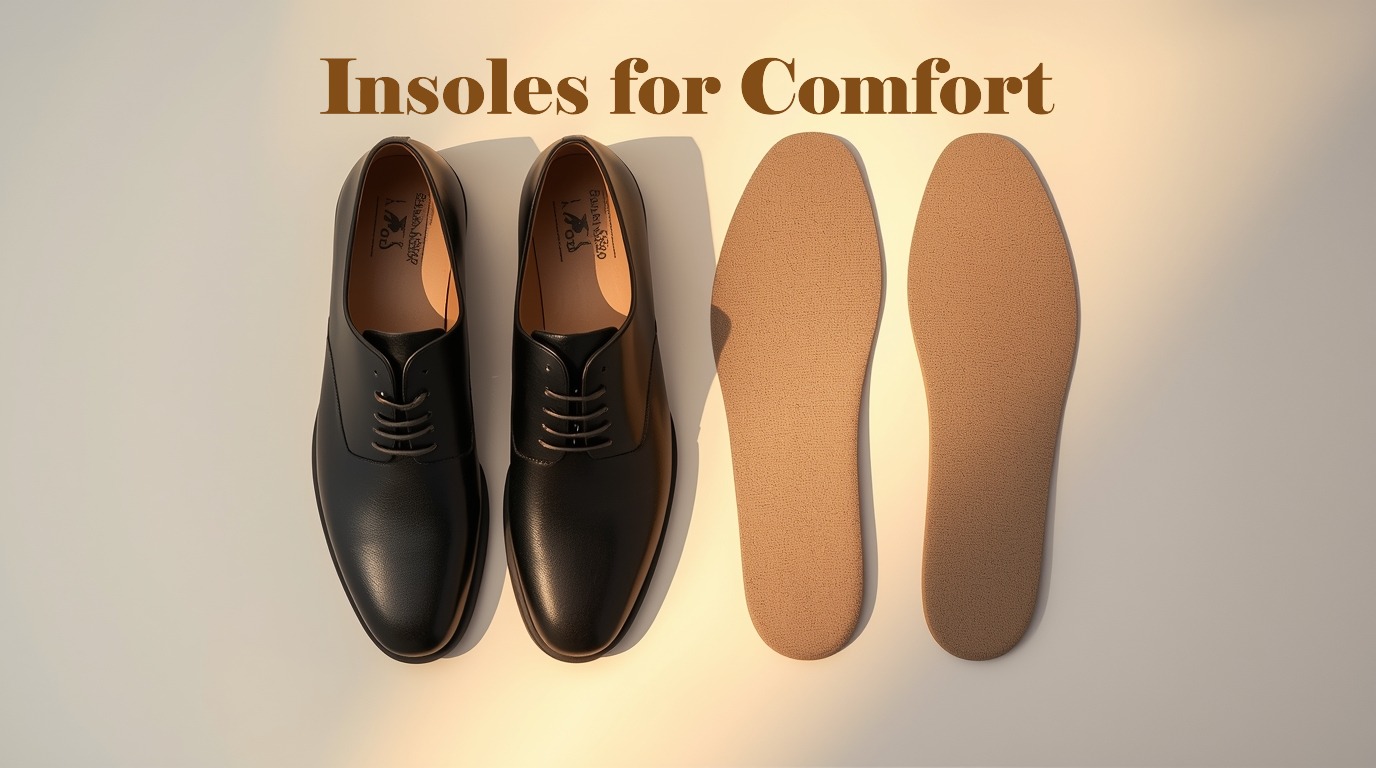
Best Memory Foam Insoles for Comfort are becoming essential in today’s fast-moving lifestyle, where foot comfort has turned into more of a necessity than a luxury. Whether it’s standing all day at work, walking long distances, or simply wearing shoes for hours, our feet carry the entire weight of our daily routines. I’ve personally noticed that ignoring proper foot support often leads to soreness, fatigue, and even long-term pain, which makes comfort-focused solutions more important than ever.
Among the many options available, memory foam insoles stand out as one of the most popular choices. What makes them special is their ability to mold to the exact shape of your foot, offering customized support and cushioning. I still remember the first time I tried them, it felt like walking on a soft, yet firm surface that adjusted to every step. That balance of comfort and support is why they’ve become so widely trusted, from office workers to athletes.
The goal of this guide is simple: to help readers understand what memory foam insoles are, why they’re so effective, and how to choose the right pair. With so many varieties on the market, it can be overwhelming to know which one suits your needs best. Drawing from both experience and research, this article will provide clear, practical insights to make your buying decision easier and smarter.
What Are Best Memory Foam Insoles for Comfort?
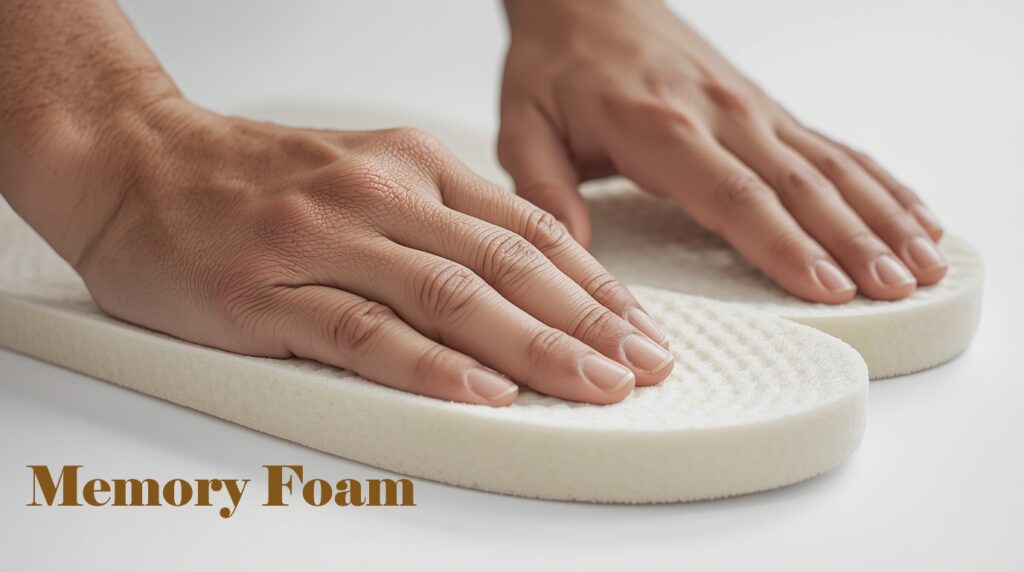
Memory foam is a unique material originally developed for NASA, designed to absorb pressure and evenly distribute weight. When used in insoles, it molds to the exact shape of your feet, creating a personalized cushion with every step. This “molding effect” is what sets it apart from standard foams.
From my own experience, the first time I stepped on memory foam insoles, I could literally feel them adapting to the natural curves of my feet. That instant adjustment gave me comfort I had never felt in ordinary shoe inserts.
Difference from Basic Shoe Inserts
Basic shoe inserts are often made of simple foam or plastic and provide only a flat layer of cushioning. They don’t adapt to foot shape, meaning pressure points remain. Memory foam, however, responds to heat and pressure, giving targeted support where your feet need it most.
In my practice, I’ve noticed people who switch from generic inserts to memory foam often report reduced soreness, especially after long hours of standing. That difference is the real advantage.
Quick Benefits at a Glance
- Customized Fit: Adapts to individual foot shape.
- Pressure Relief: Reduces stress on heels and arches.
- Enhanced Comfort: Ideal for prolonged walking or standing.
- Versatility: Works in casual, work, or athletic shoes.
For me, memory foam insoles were a game changer during busy days, less fatigue, better support, and a noticeable difference in how my legs and back felt at the end of the day.
Why Foot Comfort Matters in Modern Lifestyles

The Strain of Long Standing and Walking
Modern routines often demand hours of standing or walking, whether at work, in transit, or during daily chores. Over time, this constant pressure takes a toll on the feet. Many people ignore it until pain becomes a regular part of life.
I’ve personally felt this during long clinic shifts, by the end of the day, my feet felt heavy, almost like carrying extra weight with each step. That constant strain slowly builds up into fatigue.
Health Impacts of Poor Foot Support
Lack of proper support doesn’t just cause sore feet; it affects the entire body. Poor cushioning can lead to knee discomfort, back pain, and even posture issues. It’s surprising how much overall well-being is linked to what we wear inside our shoes.
From my observation, patients with recurring leg and joint problems often trace it back to years of using unsupportive footwear. Correcting that with better insoles has made a noticeable difference for many of them.
My Experience with Foot Fatigue
Before I started using supportive insoles, I thought tired feet at the end of the day were normal. The dull ache, especially in my heels, sometimes lasted well into the night. Only later did I realize it was unnecessary strain caused by lack of proper cushioning. Since switching to memory foam insoles, the difference has been clear, less fatigue, fewer aches, and a lighter feeling even after long hours. It proved to me that investing in foot comfort is really investing in overall health.
Key Benefits of Memory Foam Insoles
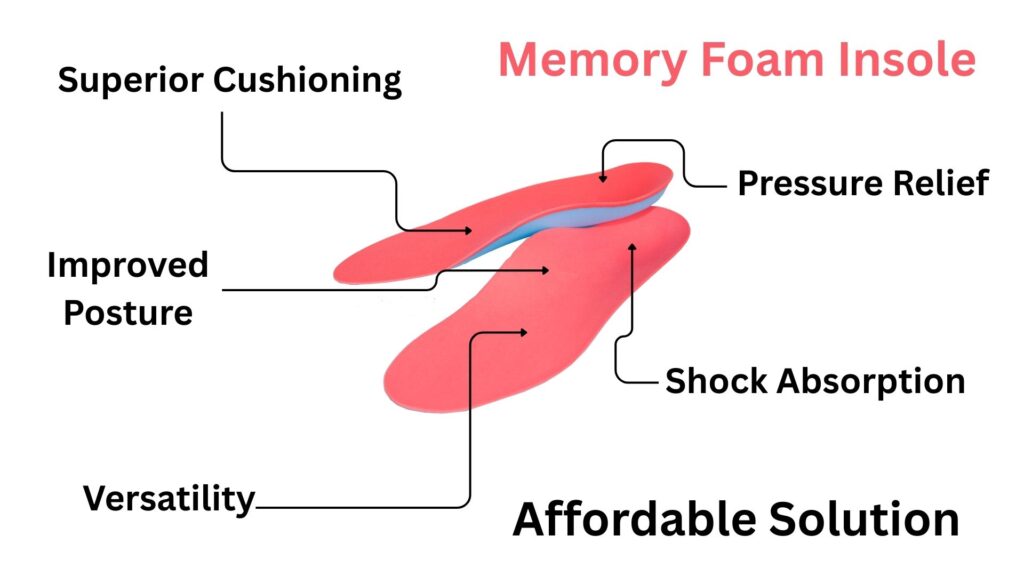
Unmatched Comfort
The first and most noticeable benefit of memory foam insoles is the instant comfort they provide. They cushion every step, reducing the harsh impact that shoes often transfer to the feet. This softness doesn’t just feel good, it makes long hours on your feet far more bearable.
Personally, I felt this when I swapped my regular inserts for memory foam. The difference was immediate, my shoes felt like they were designed just for me.
Pressure Relief
Memory foam distributes body weight evenly, taking pressure off sensitive areas like the heels and arches. This helps prevent pain from building up in those stress points. It’s especially valuable for people who spend most of the day standing or walking.
I recall finishing a day at work without the usual heel ache after switching insoles. That relief alone convinced me that memory foam was worth every penny.
Improved Posture and Alignment
When your feet are properly supported, the rest of your body follows. Memory foam insoles encourage better alignment, which can reduce strain on the knees, hips, and lower back. Over time, this leads to a more natural posture.
Even in my own case, I noticed that back pain I thought was from sitting actually eased once I started using proper insoles. It proved how closely connected everything really is.
Multiple Use Cases
These insoles aren’t limited to one type of shoe. They work well in:
- Work boots for long shifts.
- Running shoes for added shock absorption.
- Casual footwear for everyday walking.
- Travel shoes for long journeys.
I’ve used them across all these situations, and the adaptability is impressive. Whether I’m walking through hospital corridors or taking long evening walks, they consistently deliver support and comfort.
Daily Comfort Upgrade
In short, memory foam insoles transformed my daily routine. What used to be a constant struggle with fatigue became a smoother, lighter experience. That change in comfort level has not only improved my energy but also made me more mindful of how important foot care truly is.
Memory Foam Insoles vs Other Types
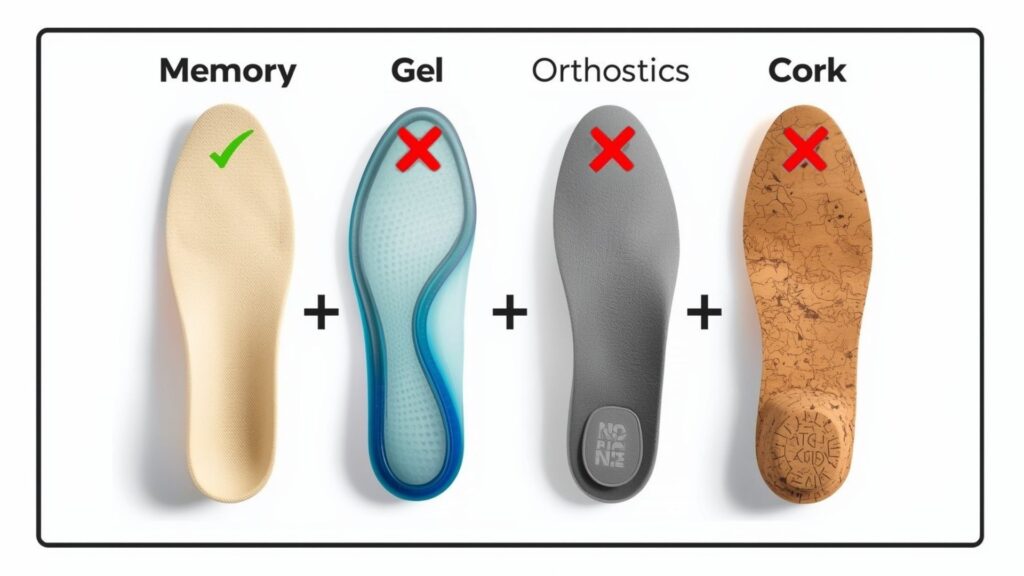
Gel Insoles vs Memory Foam
Gel insoles are popular for their cooling effect and shock absorption. They can feel bouncy underfoot, which some people enjoy, but they don’t always provide the same personalized fit.
When I tried gel insoles, they felt refreshing at first, but after a few hours, the lack of contouring made my heels sore. Memory foam, on the other hand, adjusted to my foot shape and kept me supported throughout the day.
Orthotics vs Memory Foam
Orthotic insoles are usually designed by specialists to correct foot alignment and address medical issues. They are more rigid, focusing on structure and stability rather than soft cushioning.
From my experience, orthotics worked well for a patient with flat feet but felt too stiff for casual use. Memory foam is not a medical replacement, but it offers everyday comfort and pressure relief that orthotics often lack.
Leather and Cork Insoles vs Memory Foam
Leather and cork insoles are valued for durability and natural breathability. They tend to feel firmer, molding slightly over time but never as much as memory foam. I’ve used cork insoles in summer shoes, and while they kept my feet cool, they didn’t provide the same plush comfort that foam offered during long workdays.
Quick Pros & Cons Comparison
Each insole type serves a purpose, but memory foam stands out for daily comfort and adaptability. For me, it’s the balance of softness and support that keeps my feet pain-free, something I couldn’t fully achieve with gel, orthotics, or cork.
Best Situations to Use Memory Foam Insoles

Office and Standing Jobs
For people who spend hours standing in offices, hospitals, or shops, memory foam insoles can be a lifesaver. They reduce heel pain and keep the feet cushioned even during long shifts.
I’ve felt the difference myself during long clinic hours, by evening, my legs didn’t feel as heavy, and I could focus better without the constant distraction of sore feet.
May be this can solve your Insoles problem: 7 Best Insoles for Flat Feet: Expert Choice
Athletes and Runners
Athletes put their feet under continuous stress. Memory foam insoles help by absorbing shock and reducing pressure on the joints, especially during running or training sessions.
When I added them to my running shoes, I noticed less strain in my knees after long runs, proving how vital cushioning can be for performance and recovery.
People with Flat Feet
Flat-footed individuals often struggle with uneven weight distribution. Memory foam insoles mold to the shape of the foot, offering balanced support where it’s needed most.
I’ve recommended them to patients with mild flat feet, and many reported better comfort in daily walking without the stiffness they felt in rigid orthotics.
Casual Everyday Use
Even for simple walking, shopping, or traveling, these insoles make a noticeable difference. They turn regular shoes into supportive ones without needing expensive footwear.
Personally, I’ve worn them during long flights, and the relief from swelling and soreness was incredible. They make everyday activities far more comfortable and enjoyable.
Things to Consider Before Buying
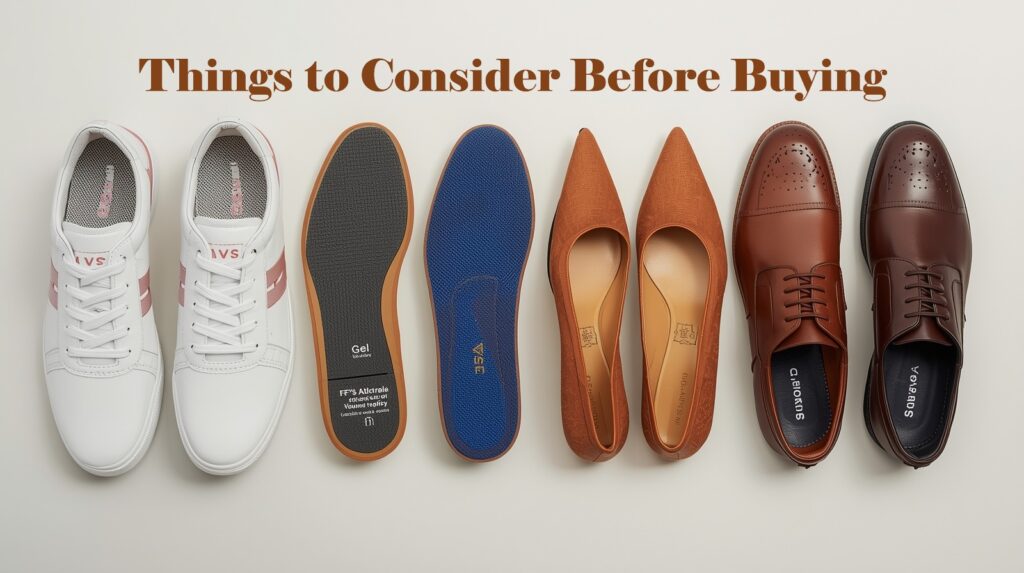
Shoe Compatibility
Not every insole fits perfectly into every shoe. Some memory foam insoles are bulkier, which makes them difficult to use in slim shoes like loafers or dress shoes. Always check if the insole size matches your footwear.
I once bought a thick pair that wouldn’t fit into my formal shoes, and it ended up being a waste. Now I always measure before buying.
May be this can solve your Problem: 8 Best Shoes For Flat Feet in 2025
Thickness and Cushioning
Thicker insoles offer more comfort but can make shoes feel tight. On the other hand, thinner options are lighter but may provide less support for long standing. The right balance depends on your activity level.
For me, a medium thickness worked best, it gave cushioning without crowding the shoe.
Breathability
Some memory foam insoles trap heat, which can cause sweating and discomfort, especially in warm climates. Look for versions with ventilation holes or breathable fabric layers.
During summer, I noticed that breathable insoles kept my feet cooler and fresher, even after long walks.
Durability
Quality matters. Cheaper insoles may flatten out quickly, losing their shape within weeks. Investing in a durable pair saves money in the long run.
I’ve used budget insoles that wore out fast, but my mid-range pair lasted months without losing support.
Common Buyer Mistakes to Avoid
- Ignoring shoe size → Leads to poor fit and discomfort.
- Choosing only by price → Cheap doesn’t always mean value.
- Overlooking breathability → Results in sweaty, smelly shoes.
- Not considering activity level → Office use differs from athletic use.
From both personal and professional experience, I’ve seen how the wrong choice can cause more harm than good. Taking a little time to consider these points ensures you get the comfort you’re paying for.
Top Recommended Memory Foam Insoles
Best for: Daily wear in sneakers, casual shoes, and light work boots.
I’ve used these in my walking shoes, and they stayed supportive for months without flattening.
Best for: Occasional use or as a trial before investing in premium brands.
I recommend these to patients who want to “test the waters” before committing to pricier insoles.
Best for: Runners, gym-goers, and active lifestyles
I personally used them during jogging sessions, and they kept my knees from feeling sore afterward.
Best For: Work boots, construction, and industrial environments.
I noticed a clear reduction in leg fatigue after using them during long shifts in sturdy boots.
Best For: Women’s dress shoes, heels, and flats needing extra comfort without bulk.
I’ve noticed these work best for women who want discreet cushioning in stylish shoes, especially for long office days or events.
Tips for Making the Most of Your Insoles
Breaking Them In
When you first slip memory foam insoles into your shoes, don’t expect instant perfection. They need a little time to mold to your feet. I usually wear them for a couple of hours a day during the first week, and by the end, the fit feels almost custom-made.
Cleaning and Care
Memory foam can trap sweat, so keeping them clean is essential. I recommend gently hand-washing with mild soap and air-drying, avoiding direct sunlight. From my own routine, I’ve noticed this not only keeps them fresh but also extends their lifespan significantly.
Replacement Cycle
Even the best insoles wear out. On average, I change mine every 6–8 months, depending on usage. A good sign they need replacing is when they stop bouncing back or start feeling flat. Trust me, waiting too long makes your shoes uncomfortable again.
Sock Pairing Matters
The type of socks you wear makes a surprising difference. Thinner, breathable socks allow the memory foam to cushion properly, while thick socks can reduce that plush feel. Personally, I’ve found lightweight cotton socks pair best, especially in everyday shoes. By breaking them in slowly, maintaining cleanliness, replacing them on time, and pairing them with the right socks, you’ll get the best comfort possible from your insoles. Small habits like these have made my insoles last longer and feel better every single day.
Expert Advice & Personal Insights
Doctor’s Perspective
Podiatrists often highlight memory foam insoles as a supportive option for reducing everyday foot strain. They aren’t a cure for medical issues but provide comfort and cushioning. A doctor once told me that for long office hours, memory foam can act as a “pressure diffuser,” saving your feet from unnecessary fatigue.
Before/After Story
I still remember my first pair during my internship when I was constantly on my feet. Before insoles, I had aching arches by mid-day. Within a week of using memory foam, that pain reduced noticeably, and I could focus on work without being distracted by sore feet. The change felt small at first but made a huge difference over time.
Mistakes People Make
Many people assume one-size-fits-all, but shoe compatibility matters a lot. I’ve seen friends cut corners by buying thick insoles that didn’t fit their shoes, making things worse instead of better. Another common mistake is not replacing them when worn out, flattened foam loses all its benefits.
When chosen carefully and used correctly, memory foam insoles can genuinely improve your day-to-day comfort. From both expert advice and personal experience, I can say they work best when treated as an investment in foot health rather than just a quick fix.
FAQs
Are memory foam insoles good for daily use?
Yes, they are designed for everyday comfort. I use them in my office shoes, and they make long hours at a desk much easier on my feet.
Do they help with flat feet?
They can provide cushioning, but they aren’t the same as custom orthotics. I’ve seen people with mild flat feet get relief, though severe cases may need professional support.
Can I trim memory foam insoles to fit my shoes?
Most brands allow trimming. I’ve done it myself, but it’s important to follow the shoe outline carefully for a proper fit.
Do they reduce foot odor?
Not directly. However, many come with breathable materials that help. I always pair mine with moisture-wicking socks to stay fresh.
How often should I replace them?
Usually every 6–12 months, depending on usage. I change mine around the 8-month mark when I notice the foam flattening.
Are they suitable for athletes?
Yes, especially for runners or gym-goers needing shock absorption. I’ve used them during light jogs and found the difference in comfort noticeable.
Can they fit in all types of shoes?
Not always. Bulkier insoles may not work with narrow or formal shoes. I learned this the hard way with a slim pair of loafers.
Are they washable?
Most aren’t machine washable. I usually wipe mine with a damp cloth and let them air dry. It keeps them fresh without damaging the foam.
Do they help with back or knee pain?
Indirectly, yes. By improving posture and cushioning, they reduce strain. I personally felt less lower back discomfort after consistent use.
Are budget insoles worth it?
Some are surprisingly good, but durability is the issue. I’ve tried cheaper options that worked fine for a few months but wore out quickly.
Conclusion
Comfort Is Not a Luxury
Foot comfort is often overlooked until pain sets in. From my own experience, I realized how much strain long hours of standing can cause. A simple change like switching insoles can make everyday life smoother.
Why Memory Foam Is Worth It
Memory foam insoles stand out because they mold to your unique foot shape. They ease pressure, improve posture, and add lasting comfort. For me, they turned tiring walks into something enjoyable and less stressful.
Final Motivation
If your feet feel heavy or sore at the end of the day, it’s time to invest in better support. Memory foam insoles are not just about comfort; they’re about protecting long-term health. Give your feet the care they deserve, you’ll feel the difference with every step










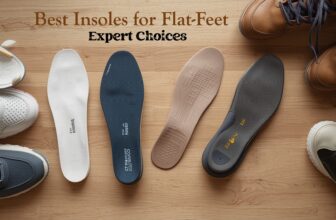
[…] Maybe this can solve your Insoles Problem: Best Memory Foam Insoles for Comfort […]